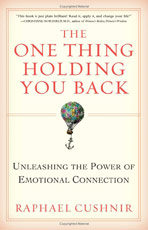Raphael Cushnir is the author of three books, including How Now: 100 Ways to Celebrate the Present Moment. He lectures worldwide and is a faculty member of the Esalen Institute, the Kripalu Center for Yoga and Health, and the Omega Institute for Holistic Studies.
One of the challenges facing people today is that we were not taught about dealing with our emotions at home, in schools, or in religious institutions while growing up. During the 1990s, Daniel Goleman's bestselling book Emotional Intelligence was the first exposure many people had to this concept and the set of traits characteristic of it, including self-control, zeal, and persistence, and the ability to motivate oneself. But Cushnir is convinced that this is only half of the story: equally important is emotional connection, which he defines as "the ability not just to recognize an emotion, but to actually feel it." In this book, he presents case histories of people who have learned and mastered this process of emotional connection. The result is "making your dreams come true in one form or another."
Cushnir begins with several core concepts of emotional connection which are:
• Emotions aren't ever entirely right or wrong, good or bad, reliable or fallible.
• Emotions contain information that thoughts alone can't.
• Emotions are physical. Our bodies are the only place they can ever be found.
Resistance to emotion is what holds us back. Cushnir believes that learning emotional connection is like training a muscle: it takes practice and persistence. He then goes on to discuss what he calls the 2 X 2 Process for ''surfing" every emotion, even the most painful ones. This is followed by a toolkit for stuck or elusive emotions consisting of breath, posture-movement-sound, touch, direct emotional inquiry, cradling, and most importantly, the practice of mental detachment.
Cushnir explains four obstacles to emotional connection: analyzing, judging, assessing, and bargaining. Also included are special tips for those moments and situations where a breakthrough may seem to not be in the making. The last section of the book delivers profile of people who have used emotional connection in dealing with addictions and compulsions, in work-related issues, in relationships and communication. There are two appendixes on lingering questions and a handy compendium of principles and practices presented in the book.
